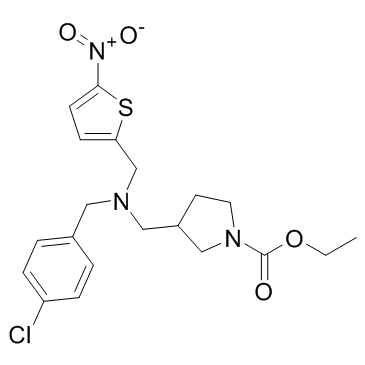1379686-30-2
| Name | Ethyl 3-({(4-chlorobenzyl)[(5-nitro-2-thienyl)methyl]amino}methyl)-1-pyrrolidinecarboxylate |
|---|---|
| Synonyms |
1-Pyrrolidinecarboxylic acid, 3-[[[(4-chlorophenyl)methyl][(5-nitro-2-thienyl)methyl]amino]methyl]-, ethyl ester
Ethyl 3-({(4-chlorobenzyl)[(5-nitro-2-thienyl)methyl]amino}methyl)-1-pyrrolidinecarboxylate SR9009 STENABOLIC SR 9009 |
| Description | SR9009 is a REV-ERBα/β agonist with IC50s of 670 nM and 800 nM for REV-ERBα and REV-ERBβ, respectively. |
|---|---|
| Related Catalog | |
| Target |
IC50: 670 nM (Rev-ErbBα), 800 nM (Rev-ErbBβ)[1] |
| In Vitro | SR9009 dose-dependently increases the REV-ERB-dependent repressor activity assessed in HEK293 cells expressing a chimeric Gal4 DNA Binding Domain (DBD)-REV-ERB ligand binding domain (LBD)α or β and a Gal4-responsive luciferase reporter (SR9009: REV-ERBα IC50=670 nM, REV-ERBβ IC50=800 nM). SR9009 potently and efficaciously suppresses transcription in a cotransfection assay using full-length REV-ERBα along with a luciferase reporter driven by the Bmal1 promoter (IC50=710 nM). SR9009 suppresses the expression of BMAL1 mRNA in HepG2 cells in a REV-ERBα/β-dependent manner. Direct binding of the SR9009 to REV-ERBα is also confirmed using circular dichrosim analysis (Kd=800 nM)[1]. |
| In Vivo | While the stress of handling and twice-daily injections caused weight loss in vehicle-treated controls, weight loss of SR9009-treated animals is 60% greater. SR9009 (100 mg/kg ,i.p.) treated mice exhibit a more severe reduction in adiposity. Plasma non-esterified fatty acids (NEFA) are also reduced (23%) along with plasma glucose (19%) in the SR9009 treated animals. In the white adipose tissue (WAT) , SR9009 treatment results in a decrease in expression of genes encoding enzymes involved in triglyceride (TG) synthesis as is also observed in lean mice[1]. |
| Cell Assay | HEK293 cells are grown in 96-well plates (1×106/well) and are transiently transfected using Lipofectamine. Cells are transfected with a total of 200 ng of DNA per well consisting of the pGL4 mIL-17 firefly luciferase reporter construct, the pGL4 mIL-17 + CNS-5 firefly luciferase reporter construct, or the pGL4 mIL-17 2kB RORE mutant (100 ng/well) , an actin promoter Renilla reniformis luciferase reporter (50 ng/well), and either control vector alone or the test DNA (full-length RORα or full-length RORγ at 50 ng/well). All 48 human nuclear receptors are represented in the specificity assay and SR9009 is tested at a concentration of 20 μM. The format of the assay is a cotransfection assay with Gal4 DNA binding domain-nuclear receptor fusions in HEK293 cells[1]. |
| Animal Admin | Mice[1] For circadian gene expression experiments male C57BL6 mice (8-10 weeks of age) are either maintained on a L:D (12h:12h) cycle or on constant darkness. At circadian time (CT) 0 animals are administered a single dose of 100 mg/kg SR9009 or SR9011 (i.p.) and groups of animals (n=6) are sacrificed at CT0, CT6, CT12 and CT18. Gene expression is determined by real time QPCR. |
| References |
| Density | 1.3±0.1 g/cm3 |
|---|---|
| Boiling Point | 547.2±45.0 °C at 760 mmHg |
| Molecular Formula | C20H24ClN3O4S |
| Molecular Weight | 437.94000 |
| Flash Point | 284.7±28.7 °C |
| Exact Mass | 437.11800 |
| PSA | 106.84000 |
| LogP | 4.17 |
| Vapour Pressure | 0.0±1.5 mmHg at 25°C |
| Index of Refraction | 1.608 |
| Storage condition | 2-8℃ |
